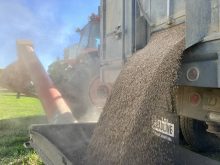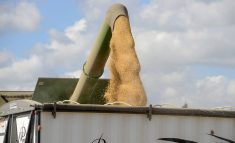ICE Futures canola contracts moved higher for most of the week ended May 17 before running into resistance, as the Canadian oilseed reacted to activity in the Chicago soybean complex.
The July contract has improved by roughly $20 per tonne off of its early-May lows over the past two weeks, and saw additional strength when activity resumed after the Victoria Day long weekend to trade at around $447 per tonne.
Many analysts are of the opinion that the seasonal lows may be in for now, but how much room there is to the upside remains to be seen, given the large old-crop supply situation and continued trade uncertainty.
Read Also

Manitoba boosts stake in cereals centre to $23.5 million
Premier Wab Kinew said the additional project funds will help ‘Trump-proof’ the provincial economy.
Soybeans started the week by falling to their lowest levels in 10 years, as China slapped tariffs on more U.S. imports and those two countries appeared to move farther apart on trade. White House tweets only heightened the tensions.
Canada’s own trade troubles with China also remain, with little optimistic news on that front.
The bigger-picture trade and political issues will continue to drive markets, but North American seeding conditions are also being watched closely.
Those conditions have generally been reasonable across the Prairies, although some areas will need moisture soon. With attention focused on spring seeding, deliveries into the commercial pipeline have slowed somewhat, but should pick up soon as there are still large on-farm supplies that will need to move eventually.
While parts of Western Canada are on the dry side, there’s entirely too much moisture across much of the U.S. Midwest. Persistent rains are causing planting delays for both soybeans and corn, with lost acres a definite possibility.
Corn is usually planted first and U.S. corn futures jumped to their highest levels in a year, as less than half of the country’s intended corn acres were in the ground as of May 19, according to a report from the U.S. Department of Agriculture, down from the five-year average of 80 per cent done. While modern machinery allows producers to make good progress when conditions allow, planting deadlines are looming and the forecasts remain wet.
Soybeans have a larger planting window, but even beans will be going in late. The U.S. soybean crop was only 19 per cent planted as of May 19, well off the average of 47 per cent. Even if all of the acres do get in the ground, quality and yields may be hurt by the later start.
The U.S. winter wheat crop is in generally good shape, but precipitation delaying the seeding of spring crops is starting to raise quality concerns in some areas. Harvest delays are another possibility.
Spring wheat seeding in the northern U.S. has also been running behind normal, with only 70 per cent of intended acres in the ground as of May 19, according to USDA.
















